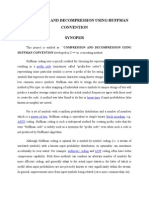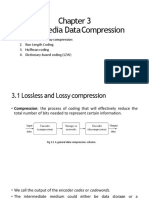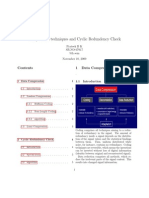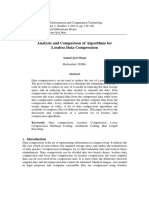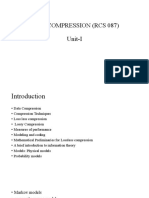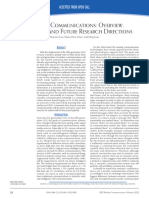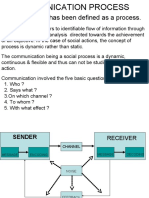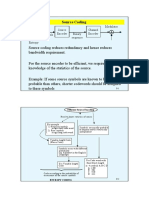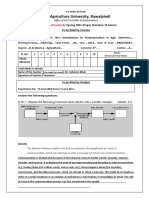20-May-19
Data Compression
Introduction to Data Compression (1)
• What is Data Compression?
• Why Data Compression?
• How is Data Compression possible?
• Lossless and Lossy Data Compression
• Static, Adaptive, and Hybrid Compression
• Compression Utilities and Formats
• Run-length Encoding
• Static Huffman Coding
• The Prefix property
1
� 20-May-19
What is Data Compression?
• Definition:
• Data compression (or Source coding) is the
representation of an information source (e.g. a
data file, a speech signal, an image, or a video
signal) as accurately as possible using the fewest
number of bits.
• Note: Compressed data can only be understood if
the decoding method is known by the receiver.
Why Data Compression?
• Data storage and transmission cost money. This
cost increases with the amount of data available.
• This cost can be reduced by processing the data so
that it takes less memory and less transmission
time.
• Data transmission is faster by using better
transmission media or by compressing the data.
2
� 20-May-19
Why Data Compression? (Contd)
• Disadvantage of Data compression:
Compressed data must be decompressed to be
viewed (or heard), thus extra processing is
required.
• The design of data compression schemes therefore
involve trade-offs between various factors,
including the degree of compression, the amount
of distortion introduced (if using a lossy
compression scheme), and the computational
resources required to compress and uncompress
the data.
How is data compression possible?
Compression is possible because information
usually contains redundancies, or information
that is often repeated.
Examples include reoccurring letters,
numbers or pixels
File compression programs remove this
redundancy.
3
� 20-May-19
Lossless and Lossy Compression Techniques
• Data compression techniques are broadly
classified into lossless and lossy.
• Lossless techniques enable exact
reconstruction of the original document from
the compressed information.
• Exploit redundancy in data
• Applied to general data
• Examples: Run-length, Huffman, LZ77,
LZ78, and LZW
• Compression ratio typically no better than 4:1
for lossless compression on many kinds of files
Lossless and Lossy Compression Techniques (Contd)
• Lossy compression - reduces a file by
permanently eliminating certain redundant
information
• Exploit redundancy and human perception
• Applied to audio, image, and video
• Examples: JPEG and MPEG
• Compression ratios typically no better than 10:1
• Lossy techniques usually achieve higher
compression rates than lossless ones but the
latter are more accurate.
4
� 20-May-19
Classification of Lossless Compression Techniques
• Lossless techniques are classified into static,
adaptive (or dynamic), and hybrid.
• In a static method the mapping from the set of
messages to the set of codewords is fixed before
transmission begins, so that a given message is
represented by the same codeword every time it
appears in the message being encoded.
• Static coding requires two passes: one pass
to compute probabilities (or frequencies) and
determine the mapping, and a second pass to
encode.
• Examples: Static Huffman Coding
Classification of Lossless Compression Techniques (contd)
• In an adaptive method the mapping from the set of
messages to the set of codewords changes over time.
• All of the adaptive methods are one-pass methods;
only one scan of the message is required.
• Examples: LZ77, LZ78, LZW, and Adaptive
Huffman Coding
• An algorithm may also be a hybrid, neither completely
static nor completely dynamic.
5
� 20-May-19
Compression Utilities and Formats
• Compression tool examples:
winzip, pkzip, compress, gzip
• General compression formats:
.zip, .gz
• Common image compression formats:
JPEG, JPEG 2000, BMP, GIF, PCX, PNG, TGA, TIFF, WMP
• Common audio (sound) compression formats:
MPEG-1 Layer III (known as MP3), RealAudio (RA, RAM, RP), AU, Vorbis,
WMA, AIFF, WAVE, G.729a
• Common video (sound and image) compression formats:
MPEG-1, MPEG-2, MPEG-4, DivX, Quicktime (MOV), RealVideo (RM),
Windows Media Video (WMV), Video for Windows (AVI), Flash video (FLV)
The following string:
Run-length encoding
BBBBHHDDXXXXKKKKWWZZZZ
can be encoded more compactly by replacing each repeated string of characters by a single instance of
the repeated character and a number that represents the number of times it is repeated:
4B2H2D4X4K2W4Z
Here "4B" means four B's, and 2H means two H's, and so on. Compressing a string in this way is called
run-length encoding.
As another example, consider the storage of a rectangular image. As a single color bitmapped image, it
can be stored as:
The rectangular image can be compressed with run-length encoding by counting identical bits as
follows:
0, 40 The first line says that the first line of the bitmap consists of
0, 40 40 0's. The third line says that the third line of the bitmap
0,10 1,20 0,10 consists of 10 0's followed by 20 1's followed by 10 more 0's,
0,10 1,1 0,18 1,1 0,10 and so on for the other lines
0,10 1,1 0,18 1,1 0,10
0,10 1,1 0,18 1,1 0,10
0,10 1,20 0,10
0,40
Run-length encoding cannot work for all files
6
� 20-May-19
Static Huffman Coding
• Static Huffman coding assigns variable length codes to symbols
based on their frequency of occurrences in the given message.
Low frequency symbols are encoded using many bits, and high
frequency symbols are encoded using fewer bits.
• The message to be transmitted is first analyzed to find the
relative frequencies of its constituent characters.
• The coding process generates a binary tree, the Huffman code
tree, with branches labeled with bits (0 and 1).
• The Huffman tree (or the character codeword pairs) must be sent
with the compressed information to enable the receiver decode
the message.
Static Huffman Coding Algorithm
• Find the frequency of each character in the file to be compressed;
• For each distinct character create a one-node binary tree containing the character and
its frequency as its priority;
• Insert the one-node binary trees in a priority queue in increasing order of frequency;
• while (there are more than one tree in the priority queue) {
▪ dequeue two trees t1 and t2;
▪ Create a tree t that contains t1 as its left subtree and t2 as its right subtree; // 1
▪ priority (t) = priority(t1) + priority(t2);
▪ insert t in its proper location in the priority queue; // 2
}
• Assign 0 and 1 weights to the edges of the resulting tree, such that the left and right
edge of each node do not have the same weight; // 3
Note: The Huffman code tree for a particular set of characters is not unique.
(Steps may be done differently).
The complexity of the algorithm on a set of n characters is
O(n log n)
7
� 20-May-19
Static Huffman Coding example
Example: Information to be transmitted over the internet contains
the following characters with their associated frequencies:
Character a e l n o s t
Frequency 45 65 13 45 18 22 53
Use Huffman technique to answer the following questions:
Build the Huffman code tree for the message.
Use the Huffman tree to find the codeword for each character.
If the data consists of only these characters, what is the total number of
bits to be transmitted? What is the compression ratio?
Verify that your computed Huffman codewords satisfy the Prefix
property.
Static Huffman Coding example (cont’d)
8
� 20-May-19
Static Huffman Coding example (cont’d)
Static Huffman Coding example (cont’d)
9
� 20-May-19
Static Huffman Coding example (cont’d)
Static Huffman Coding example (cont’d)
The sequence of zeros and ones that are the arcs in the path from the root to each leaf node are
the desired codes:
character a e l n o s t
Huffman 110 10 0110 111 0111 010 00
codeword
10
� 20-May-19
Static Huffman Coding example (cont’d)
If we assume the message consists of only the characters a,e,l,n,o,s,t then the
number of bits for the compressed message will be 696:
If the message is sent uncompressed with 8-bit ASCII representation for the
characters, we have 261*8 = 2088 bits.
Static Huffman Coding example (cont’d)
Assuming that the number of character-codeword pairs and the pairs are included at the beginning of
the binary file containing the compressed message in the following format:
7 in binary (significant bits)
a110
e10
Characters are in 8-bit ASCII
l0110 codes
n111
o0111
s010
t00
sequence of zeroes and ones for the compressed message
Number of bits for the transmitted file = bits(7) + bits(characters) + bits(codewords) + bits(compressed message)
= 3 + (7*8) + 21 + 696 = 776
Compression ratio = bits for ASCII representation / number of bits transmitted
= 2088 / 776 = 2.69
Thus, the size of the transmitted file is 100 / 2.69 = 37% of the original ASCII file
(i.e., 37% compression has been achieved)
11
� 20-May-19
The Prefix Property
Data encoded using Huffman coding is uniquely decodable. This is
because Huffman codes satisfy an important property called the prefix
property:
In a given set of Huffman codewords, no codeword is a prefix of
another Huffman codeword
For example, in a given set of Huffman codewords, 10 and 101 cannot
simultaneously be valid Huffman codewords because the first is a prefix
of the second.
We can see by inspection that the codewords we generated in the
previous example are valid Huffman codewords.
The Prefix Property (cont’d)
To see why the prefix property is essential, consider the codewords given below
in which “e” is encoded with 110 which is a prefix of “f”
character a b c d e f
codeword 0 101 100 111 110 1100
The decoding of 11000100110 is ambiguous:
11000100110 => face
11000100110 => eaace
12






























